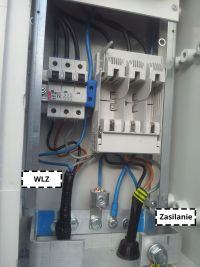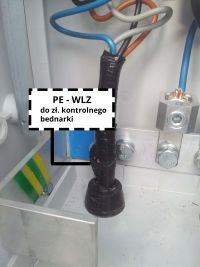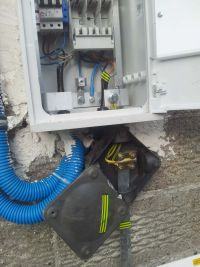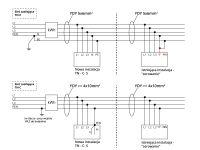Hello,
at the outset, I would like to point out that I am not an electrician, but only interested in electrical engineering and teletechnical installations. Recently, the installation in the grandparents' house will be partially modernized: the old part of the house will remain unchanged (TN-C network type, zeroing), the new one will be separated and connected to the new TN-S receiving system.
An electrician was hired to move the control and measurement system from the old part of the house to the outside. The work has been done, the tension in the house is there, but I have some comments that I would like to share with you and ask you to answer a few questions:
In my opinion:
1. Electrician split the PEN wire in the connector, and then in the old part of the house, he connected the N and PE conductors again, creating an "artificial PEN conductor". From what I understand, he introduced the working currents in the N conductor to the PE protective conductor, which is not allowed and undermines the idea of electric shock protection? Is it mentioned somewhere in the law, standards? [edit: I found studies by dr. Musiał, who writes about the stages of converting to TN-S type from TN-C] [ link How serious is this risk to humans?
2. The electrician grounded the PEN conductor separation point at the entrance of the WLZ to the building - in the junction. The question for what? Since it was possible to ground the PEN conductor, in case of damage to the pole-house section, then the separation point should be made locally in the switchgear of the modernized TN - C - S installation.
3. The cross-section of the selected cable (load) is also interesting - 6mm ^ 2. Assuming there are two families in the house and each has an oven, hob etc.
4. Am I entitled to demand from the Electrician as-built documentation for such a "small job"? He also did not provide a measurement report.
Additional questions:
1. Can RCB protections malfunction in a TN - C - S installation that is downgraded to TN-C by reconnecting PE and N conductors?
I attach some photos as well a schematic diagram of the installation made by me + in the lower part my proposed solution. Please, look and verify.
Thank you in advance and best regards.





at the outset, I would like to point out that I am not an electrician, but only interested in electrical engineering and teletechnical installations. Recently, the installation in the grandparents' house will be partially modernized: the old part of the house will remain unchanged (TN-C network type, zeroing), the new one will be separated and connected to the new TN-S receiving system.
An electrician was hired to move the control and measurement system from the old part of the house to the outside. The work has been done, the tension in the house is there, but I have some comments that I would like to share with you and ask you to answer a few questions:
In my opinion:
1. Electrician split the PEN wire in the connector, and then in the old part of the house, he connected the N and PE conductors again, creating an "artificial PEN conductor". From what I understand, he introduced the working currents in the N conductor to the PE protective conductor, which is not allowed and undermines the idea of electric shock protection? Is it mentioned somewhere in the law, standards? [edit: I found studies by dr. Musiał, who writes about the stages of converting to TN-S type from TN-C] [ link How serious is this risk to humans?
2. The electrician grounded the PEN conductor separation point at the entrance of the WLZ to the building - in the junction. The question for what? Since it was possible to ground the PEN conductor, in case of damage to the pole-house section, then the separation point should be made locally in the switchgear of the modernized TN - C - S installation.
3. The cross-section of the selected cable (load) is also interesting - 6mm ^ 2. Assuming there are two families in the house and each has an oven, hob etc.
4. Am I entitled to demand from the Electrician as-built documentation for such a "small job"? He also did not provide a measurement report.
Additional questions:
1. Can RCB protections malfunction in a TN - C - S installation that is downgraded to TN-C by reconnecting PE and N conductors?
I attach some photos as well a schematic diagram of the installation made by me + in the lower part my proposed solution. Please, look and verify.
Thank you in advance and best regards.







